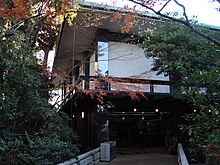Hatakeyama Kinenkan
The Hatakeyama Kinenkan ( Japanese 畠 山 記念 館 , "Hatakeyama Memorial Museum of Fine Arts") is a private art museum in Minato , Tokyo. The museum houses a collection of utensils for the Japanese tea ceremony , which were assembled by the industrialist Issei Hatakeyama (1881–1971). The collection focuses on Chinese, Korean and Japanese porcelain and paintings, especially from the Muromachi period , the prime of the tea ceremony. The 1,300 exhibits include 32 important cultural assets , six national treasures (paintings category) and tea utensils by Sen no Rikyū and his student Furuta Oribe .
Overview
Issei Hatakeyama, the founder of Ebara Saisakusho ( 荏 原 製作 所 , roughly Ebara Factory ) was born in Kanazawa in 1881 . He came from the daimyo family Hatakeyama from the province of Noto . He studied mechanical engineering at the Imperial University of Tokyo and, after graduating in 1912, founded the predecessor company of Ebara Werke. In this factory, Hatakeyama manufactured and sold the Inokuchi pump developed by his teacher Inokuchi Ariya (1856–1923) and named after him. Although a businessman, Hatakeyama was known as a tea and nō connoisseur. This fascination, especially for the Hōshō school of the Nō, has shaped his passion for collecting antiques.
Hatakeyama was also chairman of the Japan Institute of Invention and Innovation ( 発 明 協会 , Hatsumei kyōkai ); In 1960 he established the Hatakeyama Memorial Foundation to promote science and technology. The Hatakeyama Museum opened four years later, in 1964, on the border of the two boroughs of Minato and Shinagawa . In the Edo period there was a country house on the museum grounds, which was granted to the Shimazu clans by the Edo shogunate in 1669. It then served as the residence of the State Councilor and Minister for Foreign Affairs Terashima Munenori (1832-1893) from Satsuma .
The museum also has a replica of the reception hall of the Hannya-ji Buddhist temple in Nara , which Yukio Mishima used as a model for his novel After the Banquet .
Web links
- 畠 山 記念 館 . In:www.ebara.co.jp. Hatakeyama Memorial Museum of Fine Arts, 2009,accessed December 8, 2012(Japanese, Museum's official website).
Individual evidence
- ↑ 畠 山 記念 館 に つ い て . (No longer available online.) Hatakeyama Memorial Museum of Fine Arts, 2009, formerly the original ; Retrieved March 25, 2013 (Japanese). ( Page no longer available , search in web archives ) Info: The link was automatically marked as defective. Please check the link according to the instructions and then remove this notice.
Coordinates: 35 ° 37 ′ 56.3 " N , 139 ° 43 ′ 36.8" E

